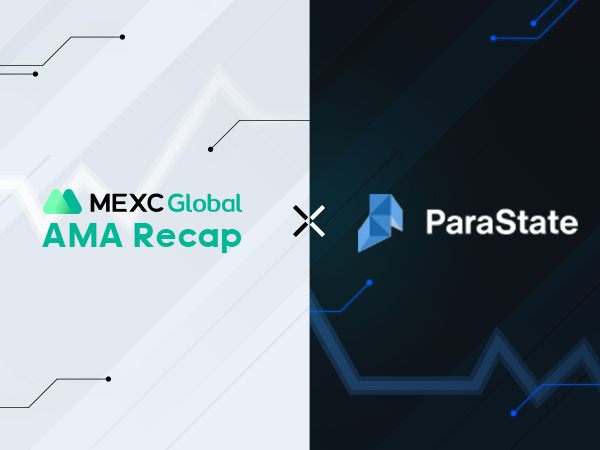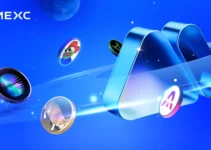In this Telegram AMA recap, you’ll find insights about the ParaState project. In an event hosted by Miranda from MEXC, you will meetMarco, co-founder of ParaState.

Introduction to MEXC AMA from ParaState:
Hey guys, I am Marco, co-founder of ParaState. I have been in the blockchain industry since 2016, first becoming a bitcoin miner and then investing in a lot of early blockchain projects. I am also a member of Rust Foundation and cohort of UC Berkeley Xcelerator 2021.
In 2018, I built a decentralized Medium-like product Ticktack, on top of SSB protocols to support 10k people relaying chats only via a $20/month cost node. This project motivated me to dive deep into the infrastructure-level of the blockchain industry.
Afterwards, I started the project ParaState with my Co-founder Michael.
Questions from community toParaState:
Question 1:
Miranda: First can you tell us what is ParaState? maybe share with us more in detail?
Marco: Known as Ethereum on steroids, ParaState is a multi-chain smart contract platform bridging the application and developer ecosystem between Polkadot, Substrate and Ethereum, as well as other chains wanting to provide Ethereum compatibility. While supporting the EVM pallet to provide seamless compatibility with all existing Ethereum applications, ParaState also provides developers with a next-gen smart contract implementation environment, Ethereum-flavored WebAssembly (EWASM). These two infrastructures are ensured to talk to each other and share the same account system on ParaState.
Among other projects which aim to provide Ethereum compatibility, only ParaState is building the virtual machine pallet from scratch by ourselves. Others just integrate the EVM-pallet into their parachains. We are bringing value to both the Ethereum and Polkadot ecosystems.
In sum, ParaState is providing an upgradable smart contract platform to developers who want to explore brand new possibilities and achieve higher performance, in the meanwhile we are backward compatible with all existing EVM applications to enable a seamless upgradable feature.
Question 2:
Miranda: Thanks Marco, next can you tell use what triggers you to launch ParaState? What are some of the real-world problems/ pain points that Parastate aims to solve?
Marco: Parastate is all about making it easy for the developer community in general. Our goal is to unify a broader developer community through our WasmEdge infrastructure.
We want to create a platform that provides scalability and high performing Ethereum compatibility; developers will therefore be able to seamlessly upgrade their projects on top of our infra. We also want to reach a wider developer community, so we are focused on building developer tools and language SDKs. We act as a connector among multi-chain ecosystems.
A specific use case can be referred to in the article.
Another unique highlight of ParaState is that we will add value to both the Ethereum and Polkadot ecosystems. Ethereum developers will have more choices in deploying their applications, and the Polkadot ecosystem will be able to directly leverage efforts from the large Ethereum developer and tooling support community.
Also, our backend WasmEdge is the first and only WASM runtime infra project recognized as an CNCF Sandbox project and hosted by CNCF. WasmEdge represents the synergy between cloud native (centralized cloud) and the blockchain (decentralized cloud) runtimes and toolings. It will help ParaState bring the much larger cloud computing developer community to the blockchain. A CNCF Sandbox project is more likely to garner mainstream adoption like Kubernetes, Envoy, Prometheus etc.
The pros associated with the Parastate ecosystem include the Layer 1 security Dapps can gain while maintaining the protocol’s composability. Another advantage is the high performance smart contract implementation environment that we provide to developers, which enables a better user experience.
Question 3:
Miranda: What about the native token of ParaState? can you tell us the token usage and it’s tokenomics?
Marco: ParaState is a decentralized autonomous organization (DAO) funded by license fees (as a percentage of gas fees) generated by transactions on other networks using ParaState technology. A short tutorial video about the token definition:
Any blockchain project that is interested in taking advantage of the technical advantages of ParaState EWASM will be charged licensing fees in the native currencies of these blockchains. Therefore, the intrinsic value of STATE is backed by a basket of native cryptocurrencies from these blockchain projects.
STATE will be used to:
- Reward “Plato” node validators to maintain an experimental showcase for advanced technology features.
- Reward dApps deployed on ParaState’s infrastructure.
- Reward token holders who stake to participate in governance.
- Enable voting on whether to kick-off a permanent L1, a parachain or a L2 based on ParaState’s technical infra.
- Bestow participation rights in the governance of the ParaState developers’ DAO treasury.
- The ParaState Foundation will manage the developer treasury and execute the decisions of the DAO at the very beginning. Ultimately, all STATE Token holders as part of the DAO will oversee and exercise decentralized governance.
- ParaState intends to initially rely on off-chain voting protocols such as Snapshot to account for votes, and will seek to develop more direct participation.
- The ParaState Foundation will manage the developer treasury and execute the decisions of the DAO at the very beginning. Ultimately, all STATE Token holders as part of the DAO will oversee and exercise decentralized governance.
- ParaState intends to initially rely on off-chain voting protocols such as Snapshot to account for votes, and will seek to develop more direct participation.
- The collection of license fees for the EWASM runtime/pallet will be distributed 90% to the DAO treasury, while the remainder (10%) will go to the long-term development reserve.
Question 4:
Miranda: Are there any exciting news or updates with regards to ParaState that you would like to share with the users?
Marco: First, ParaState will take part in the #11th parachain auction on Polkadot in March. If you are a DOT holder, please don’t hesitate to stake with us. You will be greatly rewarded.
Second, We have partnered with DoraHacks as well as other community partners to organize a Hackathon event. We will launch a new hackathon in March 2022 aiming at encouraging developers from all over the world to use ParaState’s next-gen toolset to create blockchain applications such as NFT marketplaces, DEXes, Wallets, etc. Please stay tuned.
Question 5:
Miranda: If you were to summarize your project in ONE word, what would it be? Why?
Marco: Innovative. Since we are the only team to build EWASM runtime pallet from scratch among all other project in Polkadot eco. That’s why W3F awarded us a grant in 2020 in order to integrate the innovative infra into Substrate ecosystem. And we’ve already delivered the grant last year.
Free-asking Session
Q1. What is the most ambitious goal of your project? Could share with us any Upcoming Updates?
Marco: Our ultimost goal is to bring EWASM runtime infra for massive adoption, and become the major substitute of the current EVM infra.
on-chain runtime is an OS of a blockchain, alike Windows & Mac for the laptop. we believe there must be something new to replace with the current EVM infra for scalability even though it’s not EWASM we are building now. So we are betting in a big track
Q2. According to the project’s roadmap- what are your most important next priorities?
Marco: The upcoming 1st priority is to participate in the #11th parachain auction during March 3rd-10th. If we won the slot, this new parachain will become the first valuable network accrued license fee to ParaState DAO treasury.
Q3. What is your strongest advantage that you think will make your team leading the market?
Marco: Our backend WasmEdge is the first and only WASM runtime infra project recognized as an CNCF Sandbox project and hosted by CNCF. WasmEdge represents the synergy between cloud native (centralized cloud) and the blockchain (decentralized cloud) runtimes and toolings. It will help ParaState bring the much larger cloud computing developer community to the blockchain. A CNCF Sandbox project is more likely to garner mainstream adoption like Kubernetes, Envoy, Prometheus etc. Many giants like Microsoft and Google also pass their internal open source projects for CNCF hosting.
Trying to find MEXC AMAs recaps?
It’s easy! Explore them in a special section of our MEXC blog. Find insights for other recently listed projects at MEXC like ParaState.
Join MEXC and Get up to $10,000 Bonus!
Sign Up


